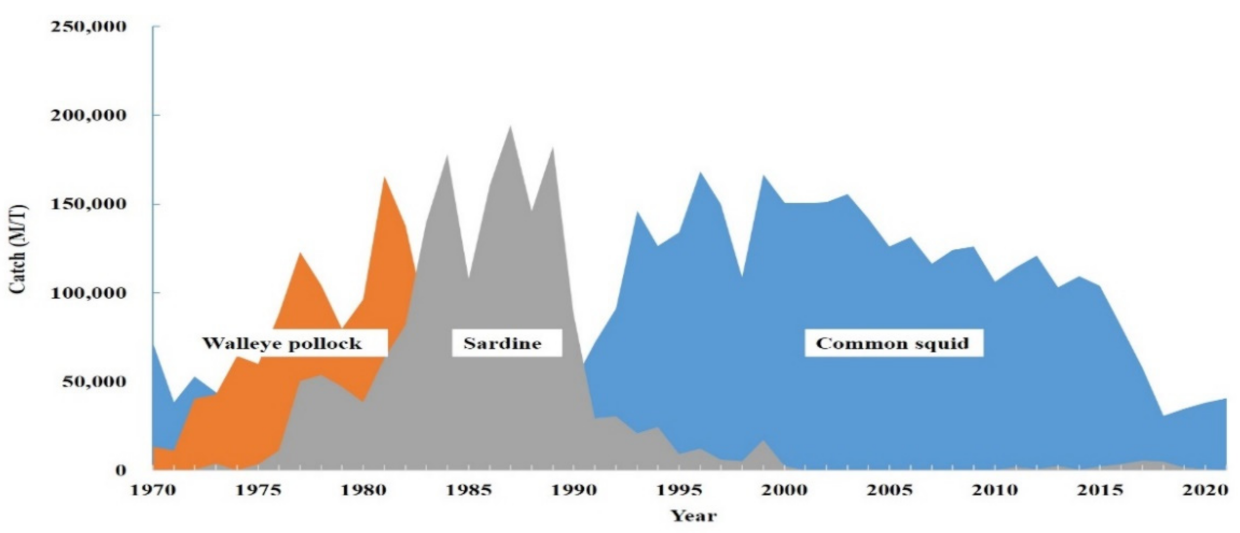Sharing Scientific Evidence of the Response of Aquatic Animals to Environmental Change
Author Contributions
Data Availability Statement
Conflicts of Interest
References
- Jung, H.K.; Rahman, S.M.M.; Kang, C.K.; Park, S.Y.; Lee, S.H.; Park, H.J.; Kim, H.W.; Lee, C.I. The influence of climate regime shifts on the marine environment and ecosystems in the East Asian Marginal Seas and their mechanisms. Deep-Sea Res. Part I Top. Stud. Oceanography 2017, 143, 110–120. [Google Scholar] [CrossRef]
- Park, T.H.; Lee, C.I.; Kang, C.K.; Kwak, J.H.; Lee, S.H.; Park, H.J. Seasonal variation in food web structure and fish community composition in the East/Japan Sea. Estuaries Coasts 2020, 43, 615–629. [Google Scholar] [CrossRef]
- Kang, H.Y.; Seong, J.; Kim, C.; Lee, B.G.; Lee, I.T.; Kang, C.K. Seasonal energitic physiology in the art shell Anadara kagohimensis in response to rising temperature. Front. Mar. Sci. 2022, 9, 981504. [Google Scholar] [CrossRef]
- Cheung, W.W.L.; Lam, V.W.Y.; Sarmiento, J.L.; Kearney, K.; Watson, R.; Pauly, D. Projecting global marine biodiversity impacts under climate change scenarios. Fish Fish. 2009, 10, 235–251. [Google Scholar] [CrossRef]
- Choi, K.; Lee, C.I.; Hwang, K.; Kim, S.W.; Park, J.H.; Gong, Y. Distribution and migration of Japanese common squid, Todarodes pacificus, in the southwestern part of the East (Japan) Sea. Fish. Res. 2008, 91, 281–290. [Google Scholar] [CrossRef]
- Urawa, S.; Sato, S.; Crane, P.A.; Agler, B.; Josephson, R.; Azumaya, T. Stock-specific Ocean Distribution and Migration of Chum Salmon in the Bering Sea and North Pacific Ocean. N. Pac. Anadromous Fish Comm. Bull. 2009, 5, 131–146. [Google Scholar]
- Rahman, S.M.M.; Jung, H.K.; Park, J.M.; Lee, C.I. Synchronicity of climate driven regime shifts among the East Asian marginal sea waters and major fish species. J. Environ. Biol. 2019, 40, 948–961. [Google Scholar] [CrossRef]
- Alam, M.D.; Kim, N.K.; Andriyono, S.; Choi, H.K.; Lee, J.H.; Kim, H.W. Assessment of fish biodiversity in four Korean rivers using environmental DNA metabarcoding. PeerJ 2020, 8, e9508. [Google Scholar] [CrossRef] [PubMed]
- Pace, M.L.; Cole, J.J.; Carpenter, S.R.; Kitchell, J.F. Trophic cascades revealed in diverse ecosystems. Trends Ecol. Evol. 1999, 14, 483–488. [Google Scholar] [CrossRef] [PubMed]
- Timmerman, C.A.; Giraldo, C.; Cresson, P.; Ernande, B.; Travers-Trolet, M.; Rouquette, M.; Denamiel, M.; Lefebvre, S. Plasticity of trophic interactions in fish assemblages results in temporal stability of benthic-pelagic couplings. Mar. Environ. Res. 2021, 170, 105412. [Google Scholar] [CrossRef] [PubMed]
- Buckland, A.; Baker, R.; Loneragan, N.; Sheaves, M. Standardising fish stomach content analysis: The importance of prey condition. Fish. Res. 2017, 196, 126–140. [Google Scholar] [CrossRef]
- Pasquaud, S.; Elie, P.; Jeantet, C.; Billy, I.; Martinez, P.; Girardin, M. A preliminary investigation of the fish food web in the Gironde estuary France, using dietary and stable isotope analyses. Estuar. Coast. Shelf Sci. 2008, 78, 267–279. [Google Scholar] [CrossRef]
- Layman, C.; Araujo, M.S.; Boucek, R.; Hammerschlag-Peyer, C.M.; Harrision, E.; Jud, Z.R.; Matich, P.; Rosenblatt, A.E.; Vaudo, J.J.; Yeager, L.A.; et al. Applying stable isotopes to examine food-web structure: An overview of analytical tools. Biol. Rev. 2012, 87, 545–562. [Google Scholar] [CrossRef] [PubMed]
- Lee, S.R.; Choi, S.-G.; Chung, S.; Kim, D.N.; Kang, C.-K.; Kim, H.-W. Geographical differences in the diet of Dissostichus mawsoni revealed by metabarcoding. Front. Mar. Sci. 2022, 9, 888167. [Google Scholar] [CrossRef]
- Barbato, M.; Kovacs, T.; Coleman, M.A.; Broadhurst, M.K.; Bruyn, M.D. Metabarcoding for stomach-content analyses of Pygmy devil ray (Mobula kuhlii cf. eregoodootenkee): Comparing tissue and ethanol preservative-derived DNA. Ecol. Evol. 2019, 9, 2678–2687. [Google Scholar] [CrossRef] [PubMed]

Disclaimer/Publisher’s Note: The statements, opinions and data contained in all publications are solely those of the individual author(s) and contributor(s) and not of MDPI and/or the editor(s). MDPI and/or the editor(s) disclaim responsibility for any injury to people or property resulting from any ideas, methods, instructions or products referred to in the content. |
© 2023 by the authors. Licensee MDPI, Basel, Switzerland. This article is an open access article distributed under the terms and conditions of the Creative Commons Attribution (CC BY) license (https://creativecommons.org/licenses/by/4.0/).
Share and Cite
Kang, C.-K.; Kim, H.-W.; Park, H.J.; Lee, C.I. Sharing Scientific Evidence of the Response of Aquatic Animals to Environmental Change. Fishes 2023, 8, 40. https://doi.org/10.3390/fishes8010040
Kang C-K, Kim H-W, Park HJ, Lee CI. Sharing Scientific Evidence of the Response of Aquatic Animals to Environmental Change. Fishes. 2023; 8(1):40. https://doi.org/10.3390/fishes8010040
Chicago/Turabian StyleKang, Chang-Keun, Hyun-Woo Kim, Hyun Je Park, and Chung Il Lee. 2023. "Sharing Scientific Evidence of the Response of Aquatic Animals to Environmental Change" Fishes 8, no. 1: 40. https://doi.org/10.3390/fishes8010040
APA StyleKang, C.-K., Kim, H.-W., Park, H. J., & Lee, C. I. (2023). Sharing Scientific Evidence of the Response of Aquatic Animals to Environmental Change. Fishes, 8(1), 40. https://doi.org/10.3390/fishes8010040







